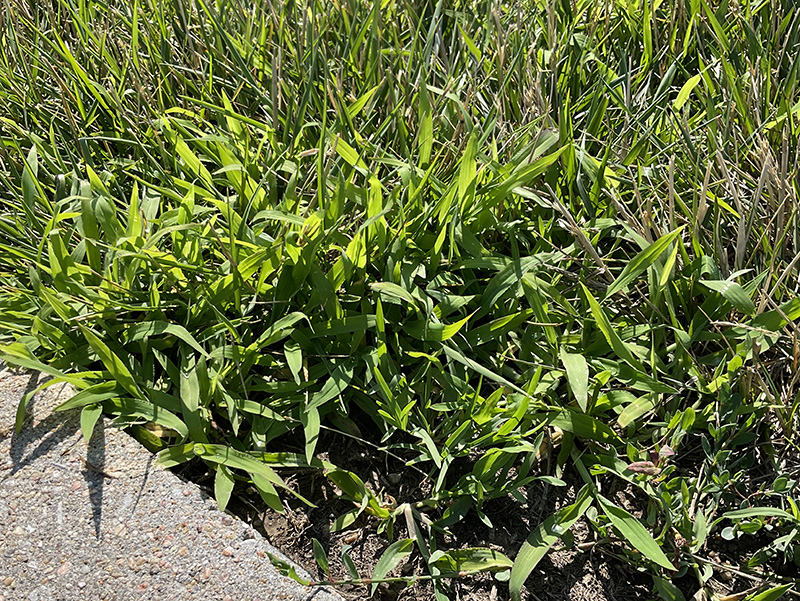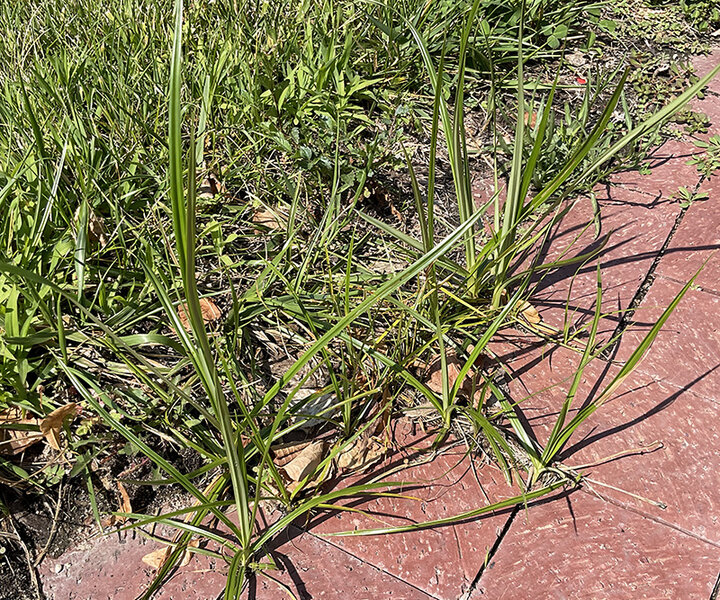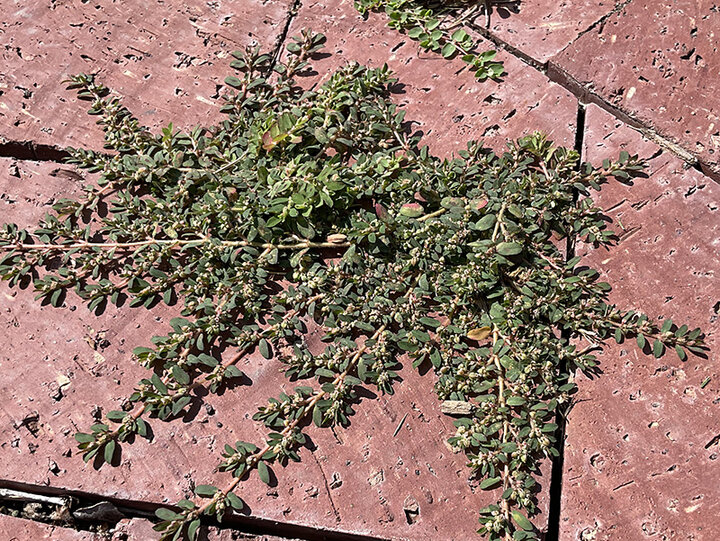Sarah Browning, Nebraska Extension Educator

The light green leaves of crabgrass are easily seen against the darker blue-green of turfgrass foliage. Image by Sarah Browning, Nebraska Extension
About this time every summer weeds begin to drive us crazy; they love the heat of mid-summer! Here are some tips to help maintain your sanity and create the best long-term strategy to minimize weeds in your landscape.
Even though weeds are most problematic now, this is one of the worst times of year to get good control. Weeds don’t translocate herbicides into their roots well at this time of year, which limits effectiveness. In mid-summer when a systemic herbicide is used, it often kills only the weed's leaves, but not the crown or roots. So they quickly recover and grow back.
In the next two weeks, we’ll discuss four main weed groups - summer annuals, winter annuals, perennial broadleaf weeds and, in a class of its own, yellow nutsedge. Each has specific timing, strategies and methods to follow for the fewest headaches on your part and the best control. We'll discuss them below in the order you should use to attack them from now through fall, starting first with yellow nutsedge and summer annuals.

Long term control of this weed is difficult for two reasons. First, each plant is perennial – it will grow back for many years if not killed. Secondly, each develops multiple little tubers on its root system, as many as 15 per plant, so if you kill the original parent plant several of the dormant tubers will grow back in its place. Where you had one plant, now you have 5.
The best strategy is to kill the new young plants before they have matured enough to develop tubers on their roots. Yellow nutsedge responds to day length; plants are triggered by long days to begin forming tubers. This year the summer solstice - the longest day of the year - was June 23, 2023, so mature yellow nutsedge plants will have begun forming new tubers.
Gardeners are often told that it’s too late to control nutsedge after plants have started to form tubers, but that’s not true. You can still kill individual plants, but realize those mature plants have already formed tubers. When you kill the original parent plant, either by pulling or a herbicide, several new young plants will take its place. Don’t think one application of herbicide will end the problem. Continue to make additional applications whenever new plants emerge and kill them before these new young plants can form their own tubers. Eventually repeated applications will provide control.
Sedgehammer, containing halosulfuron, is a good product and is available at many garden centers.Sedge Ender, made by Bonide, is another good nutsedge control product. It contains sulfentrazone which provides some pre-emergence control of the dormant tubers. When they start to germinate and grow, the chemical kills them. Again, you should be able to find this at garden centers with a good chemical selection.
Gardeners can use both Sedgehammer and Sedge Ender together. Hit the existing plants first with Sedgehammer to kill them. Then apply an application of Sedge Ender to kill tubers that might begin germinating. Plan to work at controlling this weed for several years, so you won't be discouraged. Just keep going after them.
If you don't want to use herbicides, you can achieve the same goal by hand-pulling plants. Just make sure you are consistently pull new plants as soon as they emerge, before they have time to develop new tubers. Eventually you will reduce the number of tubers in the soil and the problem will decrease. Repeated applications or hand pulling, and consistency are the keys to long term control.
On a side note, sulfentrazone is also effective at killing annual grassy weeds like foxtail and crabgrass, so can be used for multiple purposes. It's most effective against young plants, less so against the large mature plants found in many landscapes at this time of year. It is selective and will not damage your lawn grass if used properly, according to label directions.
When applying herbicides, avoid mowing about three days before and after treatment. To ensure adequate herbicide absorption, do not water the lawn for at least 24 hours after product application. Applications should ideally be started before the summer solstice, when nutsedge is young, actively growing and is most sensitive to herbicidal control. Once this weed matures, control is difficult regardless of the treatment schedule.

This type of weed regrows from seed each year and all plants die in fall. Each plant only lives for one year. Common summer annual weeds include crabgrass, foxtail, knotweed, purslane and spurge.
Seeds germinate at any time during the growing season once soil temperatures are above a minimum germination threshold. Preemergent herbicides, which kill seeds as they germinate, are one of the best ways to control summer annual weeds. Timing of the first spring preemergent application is based on the soil temperature at which crabgrass and foxtail begin germination - 55 F degrees at a 2 to 4-inch depth or several consecutive days - which usually occurs in eastern Nebraska during the last week of April or the first week of May. This timing also provides good control for many other summer annual weeds.
However, weed seed doesn’t just germinate in spring, it continues to germinate all summer long. A second application, and sometimes a third, is necessary to provide continued weed control all summer. Each preemergent herbicide has a specific residual period based on the active ingredient and product formulation. Time your second application based on the product you used.
- Trifluralin (Preen) - 8 weeks
- Prodiamine (Barricade) – 16 weeks
- Dithipyr (Dimension) – 9 weeks
- Pendimethalin (Pendulum) – 8 weeks
Do not apply more than the maximum seasonal rate of any preemergent herbicide, as specified on the product label. As always, read and follow all pesticide label directions.

Other great ways to minimize problems with summer annual weeds include the following,
- Use a 2- to 4-inch-thick layer of mulch in landscape beds to shade the soil and minimize weed seed germination. Mulch plus preemergent herbicide provides the highest level of summer annual weed control.
- Walk through landscape beds weekly and hoe out any new weeds that appear.
- Mow your lawn tall at 3 to 4-inches. This shades the soil surface and provides significant weed control compared to lawns mowed at a lower height.
- Maintain a thick dense turf. Over seed thin areas this fall to eliminate weed problems next year.
Next week we'll look at the best strategies and timing for control of winter annual and perennial broadleaf weeds.
Reference to commercial products is made with the understanding that no discrimination is intended and no endorsement by Nebraska Extension is implied. Mention does not imply approval or constitute endorsement by Nebraska Extension. Nor does it imply discrimination against other similar product
Images by Sarah Browning, Nebraska Extension.
- Yellow nutsedge plants have triangular stems and yellow-green foliage.
- Purslane has waxy succulent leaves, similar to the foliage of ground cover sedums.
- Both prostrate and spotted spurge are common in Nebraska landscapes. Spotted spurge plants have a purplish blotch in the center of each leaf, while prostrate spurge does not.
Search Our Archive
Associated Video
Controlling Nutsedge
UNL Plant Sciences Research Manager Matt Sousek talks about why yellow nutsedge is so hard to control and offers a few tips on management. UNL Turfgrass Program PhD student Luqi Li shows us how one nutsedge tuber can take over bare soil.